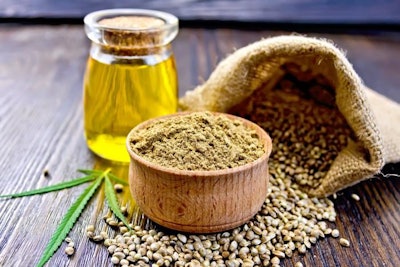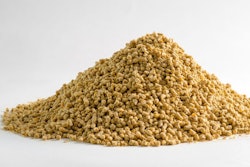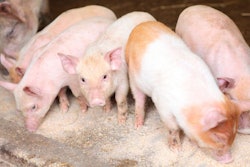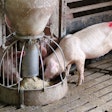
Data from hemp seed cake safety study points to possible egg quality benefits in layers
Current research points to potential benefits for the use of hemp seed cake in laying hen diets, but applications in other livestock species remain less clear, researchers said during a panel assembled by the Hemp Feed Coalition.
With an application for the approval of hemp seed cake and meal in laying hen diets under review by the Association of American Feed Control Officials (AAFCO) and the U.S. Food and Drug Administration (FDA), the Hemp Feed Coalition has turned its attention toward possible commercial uses of this and other hemp-derived feed ingredients. Research on the use of hemp in animal feed remains sparse, but three experts who spoke to the Hemp Feed Coalition’s Facebook audience last month said existing studies point to hemp’s promise as a feed ingredient.
Layers, in particular, may stand to benefit from diets containing hemp seed, according to Raj Kasula, vice president and chief nutrition officer for The Wenger Group and one of the researchers who worked on the safety and efficacy trials behind the Hemp Feed Coalition’s ingredient application.
The trials, Kasula said, evaluated multiple key performance metrics in 800 laying hens fed diets containing up to 30% hemp seed cake. Overall, he said, the impact on performance compared with conventional diets was negligible, though the hens fed hemp seed cake gained slightly more weight.
However, the study pointed to “significant improvements in egg quality parameters,” Kasula said. Eggs from the hens fed hemp seed cake contained more omega 3, and generally had a more favorable fatty acid composition. They also contained more lutein, Kasula said.
Nutritionally, hemp seed cake has more phosphorus and a good mineral content, but wasn’t necessarily a direct replacement for soybean meal, Kasula said. But overall, he said, he believes hemp seed cake has “great potential as a feed ingredient.”
Recent trials in ruminants have produced more mixed results, according to Massimo Bionaz, an associate professor of dairy nutrigenomics at Oregon State University. The vast majority of hemp produced in the U.S. today is grown for the production of cannabidiol (CBD) oil, which means the industry produces large quantities of spent biomass that could be used as an animal feed ingredient.
This spent biomass has a similar protein and fiber content as alfalfa hay, Bionaz said, but the nutritional content of the spent hemp biomass varies widely from one batch to the next, depending on the extraction process used. Spent hemp biomass also contains residual cannabinoids, which could be be considered a contaminant, depending on how regulatory decisions unfold.
One recent study also suggests spent hemp biomass may not prove popular among ruminants, Bionaz said. In the trial, five groups of finishing lambs were fed diets containing alfalfa, hemp or a combination of both. In the study’s first month, however, feed intake dropped for the lambs fed the high-hemp diets, apparently because the lambs “did not want to eat the spent hemp biomass when it was pelletized,” Bionaz said.
However, lambs fed the alfalfa-hemp mix had improved feed intake in the long-run, Bionaz said.















